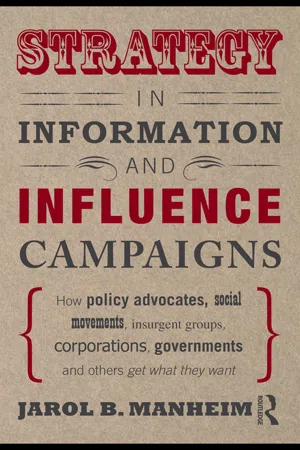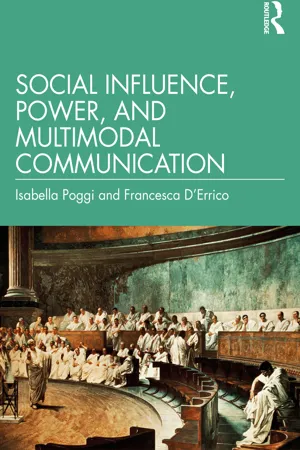Psychology
Persuasion
Persuasion refers to the process of influencing attitudes, beliefs, and behaviors of others through communication. It involves the use of various strategies and techniques to change or reinforce people's opinions or actions. In psychology, persuasion is studied to understand the factors that contribute to its effectiveness and the underlying cognitive processes involved.
Written by Perlego with AI-assistance
Related key terms
5 Key excerpts on "Persuasion"
- eBook - ePub
Human Communication
Theoretical Explorations
- Albert Silverstein(Author)
- 2015(Publication Date)
- Routledge(Publisher)
10 Cognitive and Behavioral Approaches to Persuasion Elliott McGinnies The American University The dictionary is not a bad place to begin some inquiries. If we look up the word "persuade," we find it defined in two ways. In one sense, it means to prevail on a person to do something; in another, it means to convince or induce to believe. These two definitions, the first behavioral and the second cognitive, represent in essence the two major theoretical positions that psychologists have taken on this matter. In general, when we attempt to persuade someone, we see ourselves as endeavoring to alter his beliefs or attitudes; and we usually expect our efforts to be rewarded by some change in his behavior. If the recipient of our arguments merely gives lip service to our point of view, without any concomitant change in action, we are apt to feel that we have failed in our essential purpose. Communication and Persuasion Persuasion, then, involves changes in behavior that are achieved through communication. Since communication is functionally present in nearly every type of interpersonal exchange, Persuasion becomes a rather ubiquitous aspect of social behavior. Speaking and writing are obvious forms of communication; but so is punching someone in the nose. Communication is achieved to the extent that a source exerts some control over the behavior of a recipient and is influenced by the recipient's response. Each communicant thus achieves some measure of control over the other. What do we mean by control? B. F. Skinner has frequently been misinterpreted with regard to the notion of control. What he refers to in his writings (most recently in Beyond Freedom and Dignity, 1971) is not an authoritarian or devious manipula tion of one person's behavior by another, but rather the simple fact that everyone's behavior is controlled by social or environmental stimuli in one way or another - eBook - ePub
Human Communication Theory and Research
Concepts, Contexts, and Challenges
- Robert L. Heath, Jennings Bryant(Authors)
- 2013(Publication Date)
- Routledge(Publisher)
5 Persuasion: Concepts and ContextsS ociety cannot exist without people influencing one another’s opinions and behavior through discourse. People seek influence as well as exert it. Those practices explain why Persuasion theory and research command so much interest. They deal with social influence, that is, people communicating to affect one another and to form useful opinions.In interpersonal communication, people influence each other’s judgments and behaviors; they are affected by each other’s actions and statements. Corporations influence employees’ opinions and behaviors, shape images each external public has of them, and create customer preferences for their products or services. The opinion climate inside companies results, at least in part, from management’s influence on employees and of employees’ impact on management. Persuasion, media effects, advertising, marketing, political campaign communication, and propaganda are terms that have become so entwined they are often used synonymously.More than 2,000 years ago, Aristotle (1954) studied rhetoric, the art of creating situationally relevant persuasive arguments. His interest centered on strategies a rhetor could use to persuade audience members. As Petty and Cacioppo (1986b) noted, “After accumulating a vast quantity of data and an impressive number of theories—perhaps more data and theory than on any other single topic in the social sciences,” researchers do not agree “if, when and how traditional source, message, recipient and channel variables affect attitude change” (pp. 124–125).Persuasion research is complex and problematic; generalizing about the influence process can be misleading, if not downright incorrect. Efforts to study Persuasion are frustrated by the complexity of the human mind, which is capable of receiving and weighing many influences simultaneously. Moreover, persuasive impact can result from interaction of many factors such as message variables, especially content, structure, and style. This list of variables includes those related to sources, especially credibility, interpersonal relationships (such as liking or conflict), channels, and idiosyncratic characteristics of receivers (including the extent to which people are self-interested in outcomes and expect to obtain rewards or avoid punishments by taking one action instead of another). - eBook - ePub
Media Effects
Advances in Theory and Research
- Mary Beth Oliver, Arthur A. Raney, Jennings Bryant(Authors)
- 2019(Publication Date)
- Routledge(Publisher)
8Currents in the Study of Persuasion
James Price DillardThe study of Persuasion is concerned with how messages that are intended to bring about a specific change in message recipients do or do not achieve that aim. This chapter provides a broad overview of scholarship meant to address that issue. Because Persuasion research is so plentiful, and has been for so long, my account is necessarily selective. The material that did find its way into this chapter is organized into four sections: (a) theories of attitude and Persuasion, (b) message design, (c) campaign processes, and (d) resistance to Persuasion.Theories of Attitude and Persuasion
The influence of the rhetorical tradition can be seen in the utility of four concepts articulated by Aristotle more than 2,000 years ago (Aristotle, 1991). Despite their age, logos, pathos, ethos, and kairos still provide a serviceable means of organizing contemporary theoretical perspectives.Logos
Logos is the mode of Persuasion characterized by its emphasis on logic and argument. One contemporary perspective that aligns with logos is the theory of reasoned action (Fishbein & Ajzen, 1975) and its progeny, the theory of planned behavior (Ajzen, 1991) and the integrative model of behavior (Fishbein, 2000). The most recent iteration of this framework asserts that behavior is determined by (a) beliefs about its consequences (which produce attitudes), (b) beliefs about what others do or think that the target should do (which produce perceived norms), and (c) beliefs about whether or not the target is able to execute the behavior in question (which produce control judgments). In each of these three domains, individuals reason from molecular beliefs to aggregate beliefs and, on the basis of those collective judgments, choose a course of action.The reasoned action perspective is a theory of behavior change, not a theory of Persuasion. But, its identification of the three bases of behavior has straightforward implications for message content, a thorough examination of which can be found in O’Keefe (2016). It is worth noting that members of the trio are not functionally the same. Behavior change follows from more favorable attitudes and more intense social pressure, but neither of these factors matter much unless the target sees him or herself as capable of the behavior (Yzer, 2007). Hence, favorable control beliefs constitute a necessary condition for the effects of attitudes and norms on Persuasion. - eBook - ePub
Strategy in Information and Influence Campaigns
How Policy Advocates, Social Movements, Insurgent Groups, Corporations, Governments and Others Get What They Want
- Jarol B. Manheim(Author)
- 2011(Publication Date)
- Routledge(Publisher)
While rhetoricians, democratic theorists, philosophical purists and others may object to the characterization, for the strategist substantive argumentation is often tangential and actual content peripheral to the truly essential decisions regarding the Persuasion of individuals. Far more important is an understanding of why and how such persons of interest to the campaign hold the attitudes, perceptions, preferences, beliefs, and expectations that they do, and by what mechanisms these diverse elements can be accessed and influenced. From a purely strategic standpoint, if one understands the psychological dynamics that generate and maintain these states and that govern their projection into the campaign setting, one can then shape the content of campaign communications to exploit these tendencies. Argumentation and content, then, are often best understood not as the essence of Persuasion, but rather as the pre-screened and carefully structured packaging that draws targeted individuals to engage with the campaign so that more fundamental persuasive elements, intended to take advantage of underlying psychological structures and processes, can be conveyed effectively.Psychological Structures and Processes
What might those elements be? And once identified, how can they be accessed and turned to advantage? To answer those questions we will draw primarily on knowledge developed over the last three quarters of a century or so in the field of social psychology, bringing in as well some ideas from advertising theory, political communication and other areas.As a practical matter, in approaching a persuasive effort, the strategist must be concerned with four basic questions: What perceptions and preferences does an individual, or a likeminded group of individuals, hold that are of potential interest to the campaign? How are these perceptions and preferences organized and, in the case of groups, how are they distributed; how do they relate to one another? What purpose do they serve? How, and to what extent, is the individual aware of, or committed to, them? Let us begin with these basics, then move toward a more nuanced set of considerations.One might think that the natural starting point for a characterization and analysis of the public mind is with a look at the results of public opinion polls, which purport to measure precisely such things. But in developing or understanding campaign strategy, it is often less the results of such inquiries that are of interest than the questions themselves. What is it that the strategist chooses to measure, and why? The answer to that question can be quite instructive, because opinion surveys and other campaign-related research should advance, and may well reveal, the strategist’s approach to Persuasion. - Isabella Poggi, Francesca D'Errico(Authors)
- 2022(Publication Date)
- Routledge(Publisher)
Within them, Persuasion clearly belongs to the communicative side of social influence; but at the same time, as observed in Chapter 1, communication is definitely a way to influence others. Yet, even if both communication and Persuasion are means for influence, and Persuasion necessarily exploits communication, not all communication (even requestive communication) is necessarily persuasive. If thief A, holding a gun, tells the robbed B “your life or your purse”, or if captain A orders soldier B “shoot them”, they aim at influencing B, but not at persuading him (they do not leave him free to comply or not). If A asks B “Can you pass me the salt?”, he is using communication to influence, but not to persuade (it is not in B's interest). So what is the peculiar way in which Persuasion influences through communication? Among the types of influence through goal hooking seen above, one aspect is shared, in fact, by both inducement and conviction: in both, to have B pursue goal GA, A must make B believe that GA is worth pursuing – it is a goal of high value – because it is a subgoal of some goal GB that B already has. But while in inducement, the imbalance of power between A and B does not allow the latter a truly free choice, in conviction B can freely decide whether to pursue the goal proposed by A. His belief that GA is a subgoal of GB, while in inducement can be jeopardized by internally feeling that there is something else (A's power or A's interest) to link the two goals, in conviction is strongly held by B. In this perspective, Persuasion is an action aimed at social influence that shares some features with a particular kind of speech act: advice (Poggi & Vincze, 2008b). In fact, suadeo, the Latin word embedded in the root of the word “per suas ion”, means “I give advice”. And advice (Poggi & Castelfranchi, 1990) is a particular speech act – namely, a request – in which the action the Sender requests the Addressee is in the Addressee's interest
Index pages curate the most relevant extracts from our library of academic textbooks. They’ve been created using an in-house natural language model (NLM), each adding context and meaning to key research topics.




